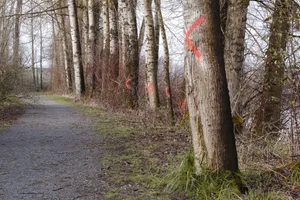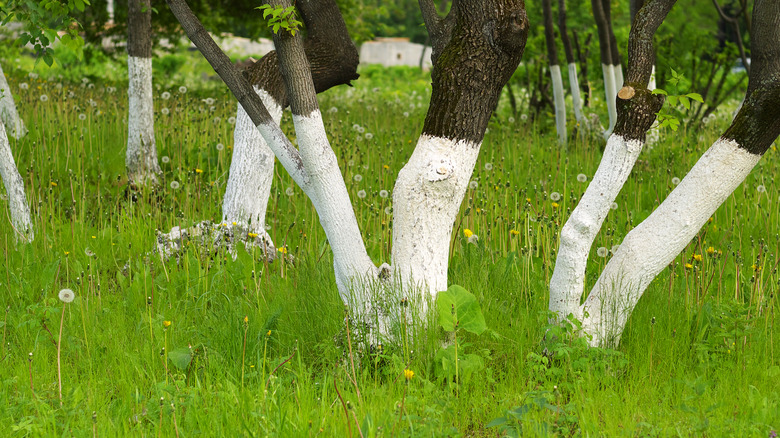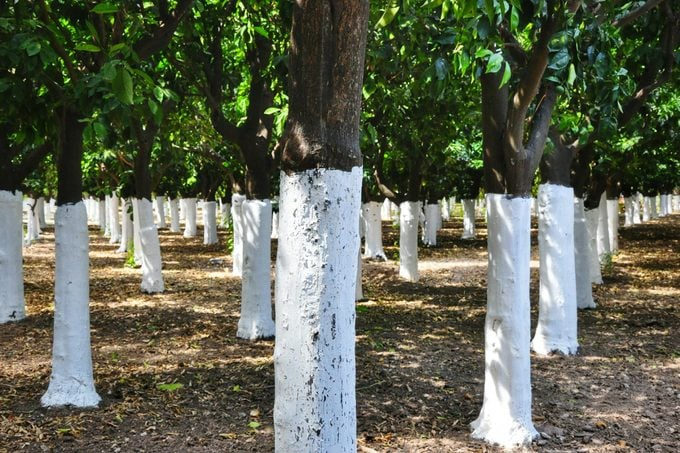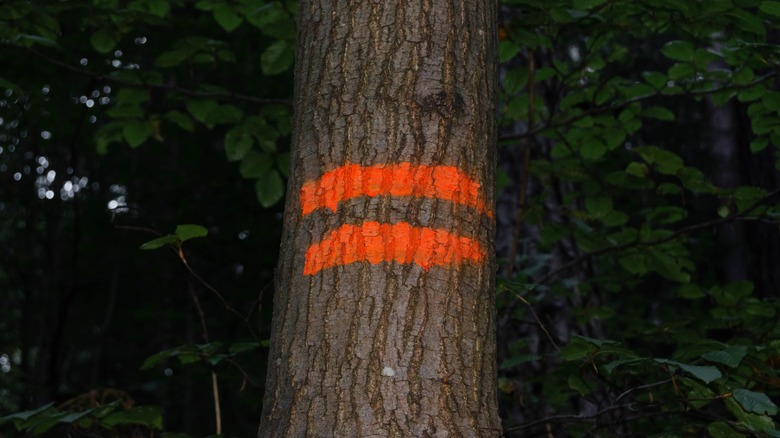Have you ever walked through a park, a city street, or a forest and noticed brightly colored paint on tree trunks? It might seem random, but those markings serve a specific purpose. From city maintenance codes to forestry management, these paint marks tell a story—one that many people don’t realize.
Different colors and symbols indicate everything from property boundaries to diseased trees. Want to decode the mystery behind these painted trees? Let’s break it all down.

Why Are Trees in the City Marked With Paint?
In urban areas, trees are often marked for maintenance, disease treatment, or removal. Each city has its own system, but let’s take Boulder, Colorado, as an example.
- Dots at the base of the tree → Indicates treatment for specific diseases, such as emerald ash borer, elm scale, or drippy blight.
- Paint at head height → Signals the tree needs pruning.
- Multiple paint dots → Some trees have been marked several times over the years, showing past maintenance efforts.
These markings help city forestry departments communicate with contractors and residents. If you see a marked tree outside your home, it likely means upcoming maintenance work.
Why Are Trees in the Forest Marked With Paint?
If you’re hiking deep in the woods and come across painted trees, they are likely part of a forestry management system.
Paint marks in forests typically indicate:
- Timber sales – Some trees are marked for removal, while others are tagged to remain untouched.
- Property boundaries – Paint is used to mark land ownership and prevent disputes.
- Environmental protection – Rare species or habitats, such as nesting sites of endangered birds, may be marked for conservation.
- Hazard identification – Dead or damaged trees posing risks may be labeled for removal.
- Trail markers – Bright colors at eye level help hikers and bikers navigate through trails.
Each state or forest service may use different colors, but generally, red, blue, and orange are common for timber management, while purple often marks private property boundaries.

Are Painted Tree Markings Universal?
Not really! There’s no universal system for marking trees, which can lead to confusion when trying to interpret them. However, some general trends exist:
- Red paint → Often used by the U.S. Forest Service to mark federal land boundaries.
- Orange or yellow paint → Typically used to define harvest boundaries or indicate which trees should be removed.
- Blue or green paint → Sometimes used to indicate trees that should be preserved rather than cut down.
- White paint rings → In some areas, this marks trees with endangered species nesting sites (such as the red-cockaded woodpecker in the Southern U.S.).
- Black paint → Often serves as a correction or “eraser” for previous markings.
While these are common practices, they are not universal. If you’re unsure, check with your local forestry department to understand what the markings mean in your area.
Why Are Some Trees Painted White?
If you see an entire tree trunk painted white, it’s not just a random choice—it serves an important function.
- Prevents sunscald – In winter, temperature fluctuations cause tree bark to expand and contract. This can lead to cracking. White paint reflects sunlight and helps moderate temperature changes.
- Protects against pests – Some orchard owners use white paint to deter insects from laying eggs in the bark.
- Helps with visibility – Trees along roadsides or in high-traffic areas may be painted white to make them more visible at night.
This method is commonly seen on young trees and orchards, where protection from the elements is crucial.

What Does Paint Marking for Emerald Ash Borer Treatment Mean?
The emerald ash borer is a destructive beetle that has been killing ash trees across the U.S. and Canada. Cities battling this pest often mark trees with paint at the base to indicate they are receiving treatment.
For example, in Boulder, Colorado, they use:
- Three different colors of paint dots → Indicate the treatment cycle, as the city rotates treatments every three years.
- Painted dots at the base → Help workers quickly identify which trees need treatment.
If you notice painted dots on ash trees in your city, they are likely being treated to prevent infestation and save them from destruction.
Is Paint Used to Deter Pests?
While some people paint trees to deter pests, experts do not recommend this practice.
- Painting over wounds or cuts can trap moisture, leading to rot and fungal infections.
- Instead of paint, proper pruning techniques and tree care help protect trees from insects and disease.
If you’re concerned about pest infestations, consider using natural pest deterrents or consult an arborist for safer solutions.

How Can You Find Out What Tree Markings Mean in Your Town?
Each city and state has its own tree marking system. If you want to know what specific painted markings in your area mean, here’s how you can find out:
- Visit your local forestry department’s website – Many cities provide maps of public trees and their maintenance status.
- Call your local parks and recreation department – They can explain the tree marking system used in your area.
- Look for informational signs – Some cities and parks post signs explaining their tree marking system.
Final Thoughts: The Story Behind Painted Trees
Next time you see a painted tree, you’ll know it’s not just random graffiti—it’s a carefully placed marker with a purpose. Whether it’s for maintenance, conservation, or property boundaries, each color and symbol tells a story.
By understanding these markings, you can appreciate the work that goes into tree management and even take steps to protect trees in your own community.
Now that you know what these markings mean, keep an eye out for them! You might just uncover some fascinating secrets about the trees in your neighborhood.